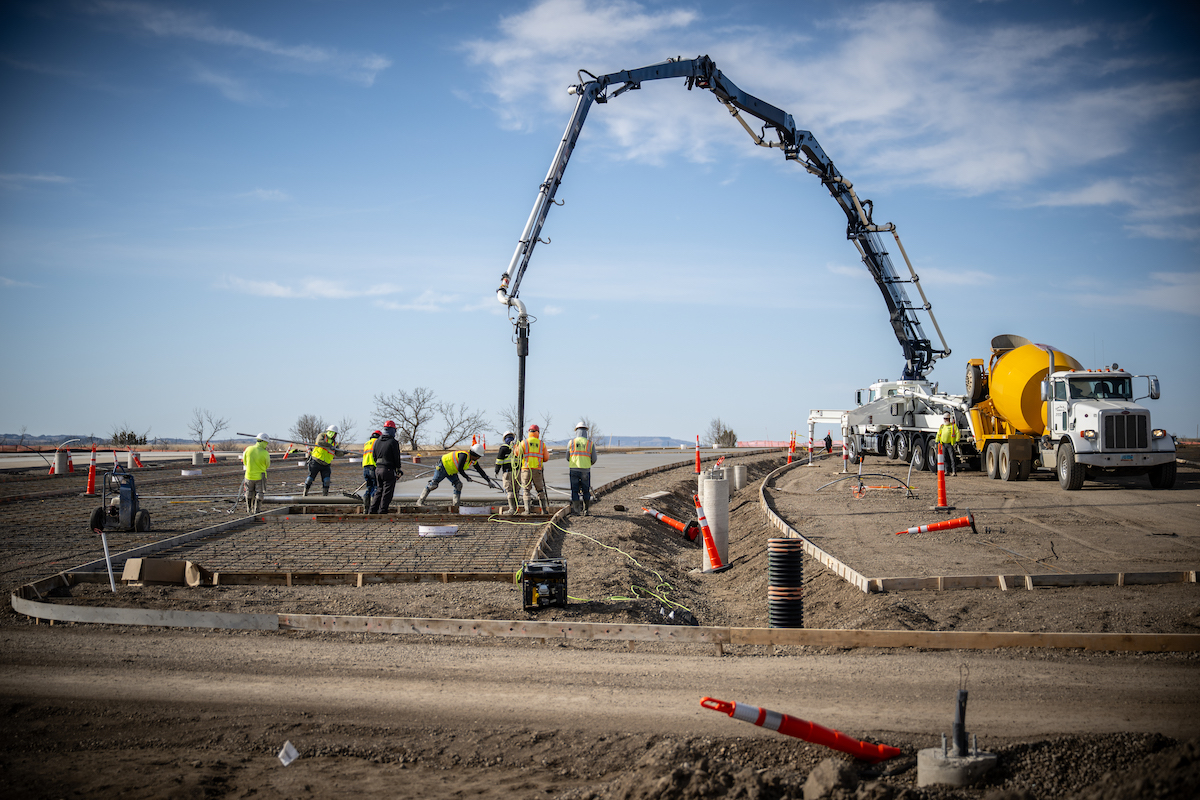“This new facility presented an exciting opportunity to use and gain operational knowledge about geo-exchange heating and cooling technology,” says Trudy Zedaker-Witte, Senior Project Manager with the University of Michigan-Architecture, Engineering, and Construction. “Geo-exchange is currently the most promising technology being evaluated for implementation across the University of Michigan campus in support of the institution’s carbon neutrality goals.”
The 163,000-square-foot, five-story instructional structure on the North Campus will house the School of Information and will provide expansion space for the Computer Science and Engineering Division of Michigan Engineering. Currently, the School of Information operations are spread across multiple buildings on campus and off campus in leased commercial spaces downtown. The building includes classrooms, student maker and dry research labs, offices, and two lecture halls.
During the past decade, enrollment in the two programs has quadrupled due to greater demand for computer science graduates to work in research, industry, and education. U-M began its computing and information curriculum in the 1950s with a graduate degree program in computing.
The university named the building after software entrepreneur Larry D. Leinweber, whose foundation made a $25 million donation for its construction. He said in a statement that he hopes, “this new gift will further advance both of these fields and amplify U-M’s impact by bringing some of the brightest minds in engineering and information science together in one collaborative setting.”

| Your local Komatsu America Corp dealer |
|---|
| Road Machinery and Supplies Company |
Walbridge of Detroit received the construction manager contract. The company began work in spring 2022, with completion anticipated in 2025.
“The university buildings are unique projects that lend themselves to craftmanship,” says Chris vanHartesvelt, Senior Project Manager with Walbridge.
Before starting construction, crews relocated existing utilities, including a chilled water line. The site was a greenfield, with no prior structure on it.
The computer science building was built into a hill, with a 50-foot elevation change from from the top of the hill to the bottom level one. Crews excavated and hauled away 110,000 cubic yards of dirt. Then the team installed an earth retention system with stepped mass 9-foot-thick concrete pours. The exterior foundation walls on the north and west sides also are massive, he says.
“It’s a robust foundation system, built in the winter months,” vanHartesvelt says. “The thick and tall foundation walls will hold back the soil load.”
Walbridge used the BIM model to coordinate mechanical, electrical, and plumbing to ensure each occupies different spaces and for prefabrication of multiple elements in the building – including electrical lighting, in-wall receptacles, switches, fire alarm boxes, and power distribution.
“We prefabricated the duct work in large sections based on the BIM model, same with large bore piping,” vanHartesvelt says. “We had as little as possible welding on site … and minimal work in the field.”
The building features a green roof, which will have dirt and small plants. The team designed the shallow concrete foundation and structural steel to support the additional loads produced by the green roof. The structural steel has some unique connections and details, vanHartesvelt reports. Brick and glass form the exterior of the building, which remains on schedule and within budget.
“We have an excellent team from the designers to construction management,” Zedaker-Witte says. “Everybody is working together for one goal.”
An interesting aspect of the project is the Hayward Street Geothermal Facility, being built in tandem with the computer science building and designed to help the university achieve its carbon neutrality goals.
SmithGroup of Ann Arbor, in collaboration with Strategic Energy Solutions of Berkley, Michigan, designed the system, which can be expanded. It has the capabilities of interconnecting with future geo-exchange systems that could be built on campus.
Geo-exchange systems depend on the constant subsurface temperature of the earth as a low-grade energy source, cooling in the summer and heating in the winter. Because these systems do not burn fossil fuels, they can be an effective resource for institutions seeking to reduce their climate impact.
University of Michigan’s President’s Commission on Carbon Neutrality hired the Integral Group of Atlanta to to assess the utility infrastructure of the university and develop a proposed approach to shift off natural gas as a fuel source, reports Andrew Berki, Director of the university’s Office of Campus Sustainability.
“Integral evaluated many carbon reduction technologies, including but not limited to, hydrogen, carbon capture, nuclear, solar thermal, biomass/biofuels, and geo-exchange,” Berki says. “The recommendation from Integral concluded that at present, the most technically and commercially viable option for the university to decarbonize its infrastructure was the electrification of our facilities using renewable electricity, purchased or on-site, combined with geo-exchange to efficiently support thermal needs.”
Work began on drilling the geothermal field in January 2023 and wrapped up in May 2023. Walbridge crews used Versa-Drill Mark70 drilling rigs to place the thermal vertical pipes. The Mark70 has 70,000 pounds of pullback and 28,000 pounds of pulldown. It works well drilling in muddy conditions, such as at the university construction site.
Crew drilled down 700 feet for each of the approximately 100 borings, which are spaced about 20 feet apart. The holes are about 4 inches in diameter. Horizontal pipes connect the vertical pipes. It is an enclosed-loop system, with no contact with the groundwater or soil.
The team has backfilled the area with dirt and will pave the site to return its use as a parking lot. The vehicles will not damage the geo-thermal system.
The university also is building a 4,000-square-foot building as part of the system, which also will be clad with bricks and will house the heat exchange pumps.
The thermal system is expected to support the Leinweber building in summer 2024 and its heating in fall 2024, after crews enclose the building.
“The University of Michigan is firmly committed to achieving carbon neutrality and fostering a shared culture of sustainability, and the Leinweber Building and Hayward Geothermal projects wholly support these initiatives in climate and sustainability,” Zedaker-Witte says.
Photos courtesy of Marcin Szczepanski/Michigan Engineering










































































